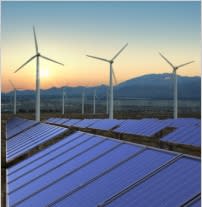How Obama Plans to `Double Down' on Clean Energy

Early in his state of the union speech, President Obama renewed his call of last year for investments in clean energy. Unbowed by the troubles with Solyndra, Obama said he would direct the defense department to throw its buying power behind clean energy supplies for the U.S. military.
The U.S. military constitutes a huge market for alternative fuels. The Air Force alone burns 2.4 billion gallons of jet fuel a year. The Department of Defense burns $18 billion worth of oil a year, four fifths of the federal governments’ energy tab.
In truth, a shift within the U.S. military to green fuels has been under way for more than a year. The U.S. Navy has been purchasing jet fuel derived from camelina a derivative of canola and a diesel like fuel derived from algae for its ships. The U.S. Air Force in 2010 began testing camelina oil in place of petroleum in its fuels as part of a program to derive as much as half of its fuel from alternative sources by 2016.
Whether Obama will be able to use clean energy to boost jobs may be tougher. A Google.org study released last summer projected that breakthroughs in clean energy technologies would add $150 billion in additional economic output and 1.1 million new jobs by 2030. (The study, “The Impact of Clean Energy Innovation,” is based on McKinsey & Co.’s Low Carbon Economics computer modeling.
For more on clean energy, see our in-depth report. http://www.scientificamerican.com/report.cfm?id=new-solutions-for-clean-energy
http://www.scientificamerican.com/article.cfm?id=a-path-to-sustainable-energy-by-2030
I will not walk away from the promise of clean energy,” Obama said during his State of the Union address. ” I will not cede the wind or solar or battery industry to China or Germany because we refuse to make the same commitment here. We have subsidized oil companies for a century. That s long enough. It s time to end the taxpayer giveaways to an industry that s rarely been more profitable, and double-down on a clean energy industry that s never been more promising.”
Follow Scientific American on Twitter @SciAm and @SciamBlogs. Visit ScientificAmerican.com for the latest in science, health and technology news.
© 2012 ScientificAmerican.com. All rights reserved.

